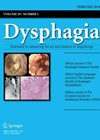
Journal Reviews
Adenoid cystic carcinoma – insights from a national database
Adenoid cystic carcinoma (AdCC) is a rare cancer of the salivary glands that accounts for approximately 1% of all head and neck malignancies. Hallmarks of this cancer type include a predilection for perineural infiltration, a prolonged clinical course with late...
Rosemary oil to aid surgical healing?
There are a multitude of ways in which to damage the nasal epithelium, whether iatrogenically through nasal surgery, via injury, allergy, infection or inhalation of an environmental pollutant. This study looks at the role of the herb rosemary, in the...
Lost and sound: exploring hyperbaric oxygen therapy for refractory SSNHL
Can hyperbaric oxygen therapy (HBOT) offer a breakthrough for patients with refractory sudden sensorineural hearing loss (SSNHL)? SSNHL is defined as acute hearing loss of ≥30 decibels in three consecutive frequencies within three days. Typically, it’s treated with two weeks...
Covid-19 and vestibular symptoms review
Since the coronavirus pandemic, there have been several studies looking into alterations within the auditory system but few in the vestibular system associated with Covid-19. This review delves into the specific evidence. It is challenging to elucidate the link between...
Pharyngoplasty for palatal snoring
This prospective Belgian study looked at the benefits of barbed reposition pharyngoplasty in the management of patients with isolated unilevel palatal snoring. This technique involves using a barbed suture and repositioning the palatopharyngeal muscle in a more lateral and anterior...
How common is oropharyngeal dysphagia amongst the adult population?
It is well known that oropharyngeal dysphagia (OD) is a symptom arising from many different aetiologies or disease conditions and that it is a significant morbidity affecting people’s quality of life. Establishing the prevalence of OD is complicated by the...
Acute mastoiditis pre- and post-Covid-19 pandemic
This retrospective single centre study evaluated the influence of non-pharmaceutical interventions (NPI) like use of face masks, hand hygiene, and contact restrictions on the incidence and severity of acute mastoiditis during the Covid-19 pandemic. The study collected data of acute...
Neonatal nasal stenosis - conservative approach
The authors retrospectively evaluated the efficacy of heated humidified high-flow nasal cannula (HFNC) in neonates with nasal stenosis for this study. Of the six infants included in the study, five had congenital pyriform aperture stenosis. Three of these five also...
The right ear advantage in noise
Relatively little is known about the right ear advantage, particularly in noise. The speech-in-noise performances were assessed in a group of 37 participants with normal hearing via a Matrix Test. Participants were tested binaurally, in a right-ear condition and a...
Ageing Ears
How do our ears show our age? We are all aware of the concept of presbycusis and a plethora of other events that impact our hearing over the passage of time. We are familiar with the standard subjective testing, though...
What type of sensitivity?
It is true that the different types of decreased sound tolerance conditions are, in general, poorly defined and the lines between them blurry. Hyperacusis? Loudness recruitment? Misophonia? Phonophobia? Sensory overload in noise? This paper aims to provide reference data for...
Person-centred care, enhancing audiology student understanding across the globe
Over 200 students registered for a multinational virtual event facilitated by the Ida Institute. The aim was to determine levels of student understanding and approaches to person-centred care (PCC), alongside the opportunity to evaluate the benefits of this approach to...















